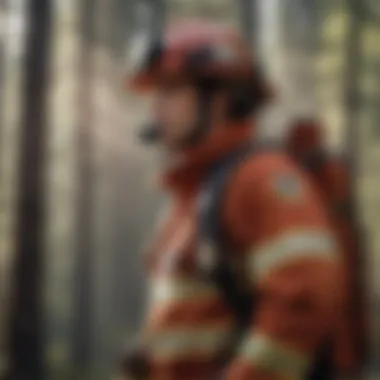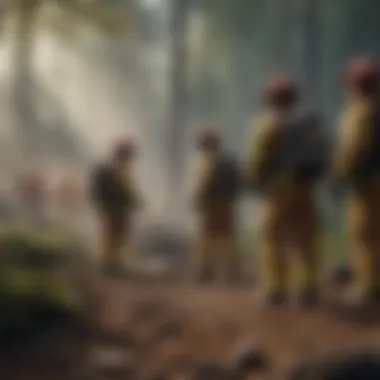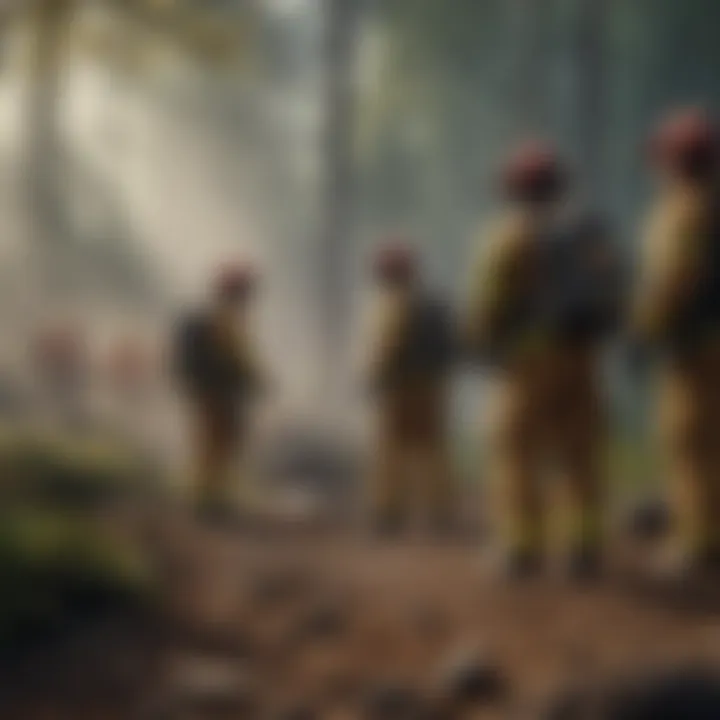Exploring Firefighter Job Openings and Opportunities


Intro
Firefighting is a noble and demanding profession that plays a crucial role in safeguarding communities. The demand for skilled firefighters has increased, with many job openings available at various levels. In this section, we will explore the nature of firefighter job openings and the qualifications needed. We will provide an overview of the application process, career advancement opportunities, and how technology is shaping the future of this vital field. Understanding the lay of the land can greatly assist aspiring firefighters in navigating their career paths.
Nature of the Profession
Being a firefighter is not limited to extinguishing fires. It encompasses a range of responsibilities, from rescuing individuals in danger to educating the public about fire safety. Firefighters often work closely with other emergency service groups and fulfill roles in disaster response and recovery.
Qualifications Needed
To become a firefighter, candidates typically need to have a high school diploma or equivalent. Additionally, many fire departments require candidates to possess specific certifications, such as Emergency Medical Technician (EMT) certification. Physical fitness is paramount. Firefighters must undergo rigorous physical training as part of the hiring process, ensuring they can handle demanding situations.
Application Processes
Applying for firefighter positions can vary across regions, but there are common elements. Often, candidates must:
- Submit an application form.
- Complete written exams which assess cognitive abilities.
- Attend physical fitness tests that challenge endurance and strength.
- Participate in interviews, which may include practical assessments.
Understanding these steps can help applicants feel prepared and confident.
Career Advancement Opportunities
Once a firefighter is on the job, several paths for advancement exist. Firefighters may progress to the rank of sergeant, lieutenant, or captain based on experience and additional training. Specialized roles, such as fire investigation or hazardous materials response, also offer opportunities for professional growth.
Impact of Technology
Technology continues to evolve within the firefighting field. Advances in fire detection systems, communication tools, and protective gear have improved safety and effectiveness in firefighting. Remote sensing technology now allows for better assessment of situations before firefighters arrive, reducing risks.
"The evolution of technology in firefighting is not just a trend but a necessity for ensuring safety and efficiency in emergencies."
Preparing for Hiring Assessments
Candidates should not only focus on physical fitness but also on developing problem-solving and leadership skills. Practicing mock interviews and studying fire science can set candidates apart. There are resources available for job seekers, including websites like Wikipedia and Britannica that offer insights into firefighting and its requirements.
Closure
Prelude to Firefighter Careers
Navigating a career as a firefighter is a significant decision that requires thorough understanding and preparation. The role of a firefighter is not merely about battling blazes; it encompasses a wide range of responsibilities, including rescue operations, emergency medical assistance, and community education. Understanding these responsibilities is crucial for anyone considering this path.
Pursuing a career in firefighting has numerous benefits. It offers a sense of purpose, camaraderie, and job stability. Furthermore, the skills acquired in this profession can be substantial in personal and professional growth. However, this is not an easy path, and aspiring firefighters must also consider rigorous training and physical requirements.
As we delve deeper, we will analyze the specifics of the firefighter role, the significance of their services in society, job market trends, qualifications, and the application process. Each of these elements is essential to providing a comprehensive overview, guiding those interested in joining this noble profession.
Understanding the Firefighter Role
A firefighter’s role extends beyond extinguishing fires. It involves a variety of tasks that require quick thinking, physical endurance, and a commitment to public service. Firefighters partake in fire suppression, hazardous material handling, and technical rescues. They continuously update their skills through training and drills to respond effectively to new types of emergencies.
Firefighters also engage with the community, educating the public on fire safety, prevention techniques, and preparedness. Their extensive knowledge in emergency response plays a crucial role in minimizing the impact of disasters. For aspiring firefighters, understanding these responsibilities is vital, as it shapes the skills needed for successful deployment in the field.
Significance of Firefighter Services
The significance of firefighter services can not be overstated. In times of crisis, these professionals provide essential support and reassurance. They are often seen as heroes, responding in moments of dire need when communities rely on swift and effective action.
Firefighters contribute significantly in several ways:
- Emergency Response: They respond proficiently to fire incidents and other emergencies, safeguarding lives and property.
- Community Education: Through outreach programs, they foster a culture of safety, equipping the public with knowledge to prevent fires.
- Disaster Preparedness: They play a pivotal role in developing and implementing community disaster response plans.
Firefighting services extend to various emergencies, providing assistance that transcends fire-based situations. Their versatility in handling diverse incidents underscores their critical presence in community safety and resilience.
Current Job Market for Firefighters
The current job market for firefighters plays a crucial role in guiding potential candidates and ensuring community safety. Understanding the dynamics of job availability is essential for aspiring firefighters. This section outlines recent trends and regional variations in job openings, offering a clear view of the landscape.


Job Availability Trends
Recent data indicates a stable demand for firefighters across many regions. The employment outlook in this field is influenced by a range of factors, including retirements, changing population demographics, and the necessity for fire services in response to climate-related emergencies.
There are several key points regarding fireman job availability:
- Retirements: As many firefighters approach retirement age, new openings emerge. Departments often need to recruit to maintain staffing levels.
- Population Growth: Areas experiencing significant population growth often require additional fire services, leading to job openings in these regions.
- Seasonal Demand: Certain regions may see peaks in hiring during wildfire seasons or periods of increased natural disasters, prompting the need for more personnel.
Data from the Bureau of Labor Statistics suggests that job availability can vary significantly by location and is also subject to funding for public safety initiatives. Being aware of these trends can help candidates identify opportunities.
Regional Variations in Job Openings
The job market for firefighters is not uniform across the country. Variations exist based on factors such as state budgets, urban versus rural settings, and local policies regarding public safety.
- Urban Areas: Typically, urban departments offer more job openings due to the larger population base. Increased incidents in these areas result in ongoing hiring needs.
- Rural Areas: Fire departments in rural areas might have fewer openings. However, these positions can be highly competitive, as candidates often seek stable employment in less populated regions.
- State-Specific Trends: Certain states invest heavily in firefighting resources, while others may face budget cuts that impact hiring. It's important for job seekers to research local departments' funding and hiring practices.
The variations in the market mean potential firefighters need to adapt their strategies based on geographical priorities. Understanding where the job openings are can significantly enhance a candidate's chances of securing a position.
"Awareness of local job markets allows candidates to tailor their applications and target the right departments."
Qualifications and Requirements
In the field of firefighting, the qualifications and requirements serve as the bedrock for a successful career. These criteria not only filter candidates but also ensure that only the most prepared individuals respond to emergencies. The focus lies on a blend of education, certifications, and essential physical traits necessary for the demands of the job. Understanding these aspects can make a difference between an average candidate and one who stands out in the hiring process.
Educational Background
A high school diploma is the minimum educational requirement for most entry-level firefighter positions. However, many fire departments prefer candidates with some post-secondary education in fire science, emergency management, or a related field. This education builds a foundation in firefighting principles and prepares individuals for the complexity of emergencies they will face.
Courses in psychology and human behavior can also prove advantageous. They provide insight into handling crisis situations, fostering communication skills with the community, victims, and team members alike. Moreover, some fire departments offer stipends or additional hiring incentives for candidates with relevant degrees.
Certifications and Training Programs
Certifications are crucial for aspiring firefighters. Common certifications include the Emergency Medical Technician (EMT) certification, which is often a requirement. Firefighter 1 and 2 certificates underscore an individual’s readiness to operate in different situations and levels of emergencies. These courses cover essential theoretical knowledge and hands-on skills.
Local fire academies and community colleges provide training programs that cater to various competencies, including hazardous materials handling and fire prevention techniques. Engaging in internship opportunities can also be beneficial. They provide practical experience in real-world scenarios, enhancing a candidate's application.
Physical Fitness Standards
Physical fitness is not merely recommended; it is essential in the firefighting profession. Firefighters face intense situations that require heightened endurance, strength, and agility. Most departments implement rigorous fitness assessments to evaluate candidates’ capabilities.
Standard tests may include tasks such as climbing ladders, hauling equipment, and dragging hoses. Engaging in strength training, cardiovascular exercises, and flexibility routines can better prepare candidates for these evaluations.
"Physical role readiness is not just about passing tests, it's about ensuring that firefighters can perform effectively when lives are at stake."
Maintaining physical wellness is an ongoing obligation for firefighters. Those who prioritize fitness not only safeguard their health but also enhance their performance on the job.
Application Process for Fireman Positions
The application process for fireman positions is a crucial aspect for those aspiring to enter this profession. Understanding how to navigate this process can significantly enhance job seekers' chances of success. Each step serves a purpose, ensuring the right candidates are selected for an essential role in community safety. Therefore, familiarity with the various components involved is vital.
Navigating Job Listings
Finding job listings for firefighter positions involves several strategies. Online platforms can be valuable resources, including department websites, local government postings, and specialized job boards. Websites like Indeed and LinkedIn also offer extensive listings. It’s important to use specific search terms, such as "firefighter jobs" or "fire department openings." This specificity helps to filter out irrelevant positions.
Networking is another effective method. Engaging with current firefighters through platforms like Facebook or even Reddit can provide insider knowledge about upcoming openings and tips to succeed in the application process. Many fire departments also host recruitment events or informational sessions where potential applicants can meet hiring officials and learn more about available positions.
Preparing the Application
When preparing the application, attention to detail is critical. A well-structured resume that highlights relevant experience and skills can set a candidate apart. Include any volunteer firefighting experience, relevant certifications, and any specialized training. The cover letter should convey why an applicant is interested in a firefighting career and what they can bring to the role.
Documents such as proof of certifications and records of physical fitness should also be prepared in advance. It is essential to follow each department's specific application instructions, as failing to do so may result in disqualification.
"A strong application is not just a formality; it reflects the candidate's dedication to this demanding profession."


Understanding the Interview Process
The interview process for fireman positions is often rigorous. Candidates are usually interviewed by a panel that may include firefighters, officers, and human resources personnel. Understanding what to expect can alleviate some anxiety.
Preparation is key. Candidates should familiarize themselves with common interview questions that assess physical fitness, teamwork, and problem-solving abilities. It is also beneficial to know about the department's mission, values, and recent initiatives.
Mock interviews can help improve performance. Practicing responses with a friend or mentor can build confidence. In addition, being prepared for scenario-based questions can showcase a candidate's critical thinking skills and understanding of firefighting challenges.
Advancing in the Fire Service
Advancement in the fire service is crucial for both personal development and the overall efficacy of the firefighting profession. This sector not only requires individuals to be skilled firefighters but also effective leaders, educators, and innovators. With the proper focus on growth and development, one can navigate the complexities of this field with much greater success. Understanding how to progress from basic firefighting duties to specialized or leadership roles can be a game changer in one’s career.
The fire service is constantly evolving, and with it, the opportunities for advancement. Engaging with career pathways and promotions can lead to roles that not only offer better compensation but also greater responsibilities and the chance to impact the community positively. It ensures firefighters are equipped to handle the challenges of modern-day emergencies and promotes a culture of continuous learning and adaptation.
Promotions and Career Pathways
Promotions within the fire service often follow a structured path, rooted in experience, training, and education. Becoming a firefighter is just the beginning. Gradually, there are options to move into positions such as engineer, lieutenant, captain, and beyond. This hierarchy allows for clear goal-setting and benchmarks for achievement.
To facilitate these advancements, many fire departments require specific qualifications. This can include:
- Continuous Education: Pursuing further education, like degrees in fire science or public administration, enhances both knowledge and career prospects.
- Firefighter I and II Certifications: Obtaining these certifications is often necessary for entry-level promotions.
- Leadership Courses: Many departments provide opportunities for aspiring leaders to take courses in incident command and emergency management.
Developing soft skills is also just as vital as technical skills. Strong communication, critical thinking, and decision-making capabilities are essential for those looking to advance.
Specialized Roles within Fire Departments
Specialization in the fire service is becoming increasingly important. As demands grow for diverse skills, specialized roles are emerging that cater to specific needs within firefighting and emergency response. These roles can greatly vary, from technical rescue teams to fire prevention specialists. Each specialty offers unique challenges and learning opportunities.
Some notable specialized roles include:
- Hazardous Materials (HazMat) Technician: Responders trained to handle chemical spills and hazardous situations.
- Fire Investigator: Professionals who determine the causes of fires, requiring inquisitive minds and analytical skills.
- Wildland Firefighter: These experts deal with forest fires and require extensive training specific to wildfire environments.
Advancing into these specialized roles not only contributes to one's career but also enhances the overall capability of the fire department. Staying informed on industry trends and continuously developing skills in these areas is paramount. Each specialized path demands commitment to ongoing training and education, which ultimately yields a more effective firefighting force.
"Continuous improvement and adaptation are what set successful firefighters apart in a rapidly changing environment."
Resources for Aspiring Firefighters
Aspiring firefighters must equip themselves with a variety of resources to navigate the complexities of this profession. These resources can enhance their understanding of the field, improve their qualifications, and increase their chances of securing job openings. The importance of having access to effective tools cannot be overstated. Those aiming to become firefighters must leverage available mentorship programs, networking opportunities, and online platforms dedicated to job searches. Each element plays a crucial role in building a strong foundation for a successful firefighting career.
Mentorship Programs and Networking
Mentorship programs in firefighting offer invaluable guidance and support to new entrants in the field. These programs typically connect aspiring firefighters with experienced professionals who can provide insights into the day-to-day realities of the job. Participating in a mentorship program allows candidates to ask questions about training, career paths, and challenges they might face in their roles.
Networking is equally essential. By attending events and engaging with other firefighting professionals, candidates can build relationships that may lead to job opportunities. Networking opens doors to potential job leads, references, and valuable advice.
Some key organizations that offer mentorship programs and networking opportunities include:
- National Fire Protection Association (NFPA)
- International Association of Fire Fighters (IAFF)
- Local Fire Departments that host community events
Getting involved through these channels can facilitate a deeper understanding of the firefighting environment and create lasting professional connections.
Online Platforms for Job Searches
In today’s digital age, online platforms serve as essential tools for job seekers in the firefighting field. Websites like Indeed, FireCareers, and LinkedIn are excellent resources for finding job openings, exploring different positions, and understanding salary ranges. These platforms often have filters that allow users to search for jobs based on location, role, and experience level.
Job seekers should also consider specialized platforms like FirefighterJobs.com. These sites focus solely on firefighting roles, providing a tailored search experience.
Furthermore, organizations often post their job openings on social media platforms like Facebook and Reddit. Engaging with firefighting community groups on these platforms can lead to additional job postings and insights.
"Connecting with others in your field can greatly improve your chances of landing a job in the firefighting profession. The more voices you hear, the more valuable information you gain."
In summary, aspiring firefighters need to utilize a mix of mentorship programs, networking opportunities, and online job search platforms. Each of these resources contributes to building a robust career and navigating the unique challenges of the firefighting profession.


The Impact of Technology on Firefighting
The introduction of technology in firefighting has revolutionized the way fire departments operate. The importance of this topic in the article cannot be overstated. Given the demanding nature of the job, advancements in technology not only enhance safety but also improve efficiency. Firefighters can now access critical data instantaneously, giving them the upper hand in emergency situations.
This section delves into specific technologies that are transforming firefighting operations, the benefits these tools provide, and considerations that must be taken into account as the industry embraces these advancements.
Emerging Technologies in Firefighting
Firefighting now encompasses a variety of emerging technologies that aid in different aspects of the job. Among these technologies are thermal imaging cameras, drones, and advanced communication systems.
- Thermal Imaging Cameras: These devices allow firefighters to see through smoke and identify hotspots. This capability is crucial during search and rescue operations.
- Drones: Unmanned aerial vehicles provide aerial views of fire scenes. They can quickly assess the situation from above, helping crews determine priorities and strategies.
- Advanced Communication Systems: Innovations in radio systems and personal safety devices improve team coordination and enhance communication during emergencies.
These technologies provide firefighters with more tools to handle complex firefighting scenarios, allowing for better strategic planning and execution.
Impact on Job Roles and Responsibilities
The integration of technology into firefighting roles has necessitated a shift in job responsibilities. Firefighters are now required to have a certain level of technological proficiency. This shift may involve:
- Understanding Data: Firefighters must analyze and interpret data from various applications and devices to make informed decisions on the scene.
- Operating New Equipment: Familiarity with drones, thermal imaging, and other advanced tools is essential. Training programs have thus adapted to incorporate these technological elements.
- Promoting a Culture of Adaptation: Embracing new technologies requires that fire departments foster a culture that encourages adaptability and continuous learning among personnel.
As the profession evolves, ongoing education and training play a pivotal role in ensuring that firefighters are equipped to handle modern challenges effectively.
"The evolving landscape of firefighting underscores the necessity of combining traditional skills with new technological tools to safeguard communities better."
These developments in technology reflect a significant change in both the firefighting field and the requisite skills for those pursuing careers within it.
Challenges Faced by Firefighters
Firefighters encounter a variety of challenges during their careers. These obstacles not only affect their personal lives but also impact the effectiveness of their services. Understanding these challenges is essential for future firefighters and stakeholders in the fire service. It sheds light on the resilience required in this profession and highlights the need for appropriate support systems. The following sections delve into the specific challenges of trauma and mental health issues, as well as the physical dangers that firefighters frequently confront.
Trauma and Mental Health Issues
Firefighting is inherently stressful. Each call brings the possibility of encountering traumatic scenarios. From witnessing loss of life to responding to serious accidents, the emotional toll can be significant. Many firefighters experience post traumatic stress disorder (PTSD). This condition can manifest in various ways, such as anxiety, depression, and mood swings.
Furthermore, mental health issues are often stigmatized within the profession. Firefighters may feel pressured to appear strong, avoiding discussions about their struggles. This can lead to isolation and worsen mental health problems. To combat this, some fire departments are increasingly recognizing the need for mental health resources. Counseling services, peer support programs, and mental health awareness training are becoming more common.
It's important for firefighters to seek help when needed. Support from colleagues and professional mental health experts can enhance resilience among first responders. It is vital, not only for their own well-being but also for their ability to serve the community efficiently.
"Mental health is just as important as physical fitness in the job of firefighting."
Physical Dangers and Risk Management
The nature of firefighting is dangerous. Firefighters are exposed to hazardous environments, including extreme temperatures, dangerous chemicals, and unstable structures. These risks are prevalent during firefighting emergencies and require careful management practices.
Each department trains its personnel on standard safety protocols, yet accidents can still happen. Common injuries range from burns and smoke inhalation to falls and equipment-related injuries. For this reason, maintaining physical fitness is crucial. Firefighters must be physically prepared to handle demanding situations.
Risk management plays a vital role in minimizing dangers. Fire departments use strategies that include:
- Regular safety drills
- Protective gear inspections
- Continuous education on the latest firefighting techniques
By prioritizing risk management, the safety of firefighters can improve dramatically. Focusing on these challenges not only promotes better health outcomes for individual firefighters but also ensures a more effective and prepared fire service for the community.
Concluding Thoughts on Firefighter Careers
The discussion surrounding firefighter careers is essential to understanding the broader context of public safety and community service. Firefighters play a critical role not only in responding to emergencies but also in educating the community on fire prevention and safety measures. Their work extends beyond merely extinguishing fires; it involves being a cohesive part of the community fabric, often being the first responders in a crisis.
Reflection on the Role of Firefighters
Firefighters serve as protectors and educators in their communities. Their responsibilities encompass everything from fighting fires to conducting life-saving rescues. They engage in continuous training to handle various situations effectively, which ranges from hazardous material incidents to natural disasters. This versatility makes them invaluable.
The emotional and social impact of their work cannot be overstated. Communities often rely on the visible presence of firefighters to foster a sense of security. Furthermore, the personal sacrifices made by firefighters, including long hours and potential exposure to trauma, highlight their dedication to public welfare. Firefighters embody resilience and commitment, offering support to those in need, while often facing psychological challenges themselves.
Future Outlook for Firefighter Employment
The future of firefighter employment is promising yet complex, influenced by factors such as technological advancements and demographic changes. As communities grow, the demand for skilled firefighters will likely increase. Yet, the profession is also evolving. With the introduction of new technologies like drones and smart firefighting equipment, the nature of the job is changing. Firefighters must adapt to work alongside these innovations while continuing to develop their skills.
Moreover, awareness of mental health issues and workplace conditions is growing. Future employment will likely prioritize not just the physical capabilities of firefighters but also their mental well-being. This evolution signifies a shift in training programs and support systems. The commitment to improving firefighter welfare promises to enhance job satisfaction and retention rates.
In summary, the firefighting profession is an integral part of public service. The career offers ample benefits but also presents significant challenges. Those considering this career must reflect on its demands and rewards. As the landscape of firefighting adapts, so too must the professionals within it, ensuring they are prepared for both current and future responsibilities.







